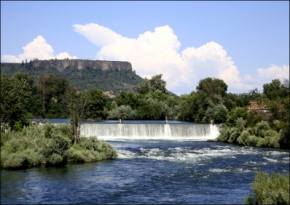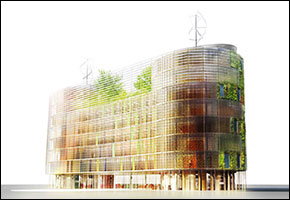Dams Demolished, Rivers Revived
 Dam decommissioning accelerates in the Pacific Northwest
Dam decommissioning accelerates in the Pacific Northwest
After the removal last week of the Rogue River’s Savage Rapids Dam in Oregon, attention is now shifting upstream to the Gold Ray Dam.
Three dams have been removed on the Rogue and the Gold Ray Dam could be gone by next year, KDRV.com reported early last week. Sediment contamination tests in August came back negative and a report on wetland impact is due soon. County commissioners have not voted yet to remove the dam, but, in order to access federal funds, the dam must go by October 2010.
In Washington state, preliminary tests were also completed to prepare for decommissioning the Elwha and Glines Canyon Dams, according to the Peninsula Daily News. Red dye was dumped in the water to provide hydrologists a picture of the river’s flow patterns. The two dams are slated to be removed in 2011.
A draft agreement has also been reached to remove dams on the Klamath River in California and Oregon, according to the New York Times. PacifiCorp, the utility operator on the river, will begin decommissioning by 2020. But U.S. Secretary of the Interior Ken Salazar must declare if the project is in the public’s interest by 2012 before it goes forward.
PacifiCorp’s customers would foot much of the bill through rate increases.
The rate of dam building peaked in the United States and Europe in the 1960s. Since most dams are built with a productive life expectancy of 50 years, those regions are about to enter a period in which decisions about decommissioning – and who will pay for it – will be contentious political issues.
Decommissioning occurs for a variety of reasons. A dam may no longer be economically productive or comply with newer, more stringent safety regulations. As a result, retro-fitting and maintaining the dam outweigh the benefits it provides. Concerns about fish population health and declining fishing industries have also prompted decommission.
Debates about decommissioning are likely to increase in the coming years.
Battles over dam removal involve many parties: the fishing industry relies on free-flowing rivers; utility companies and their customers want the electricity from hydroelectric plants; irrigators use the reservoirs behind dams to water their fields; downstream inhabitants want flood-protection; and environmentalists bemoan the loss of habitat.
Meanwhile the tourism industry is torn. A large reservoir provides boating and recreational activities, while an undammed river attracts rafters and fishermen.
In other parts of the world, dam building peaked later. In Asia, construction peaked during the late 1970s, while dams in Africa were popular in the 1980s. Unlike the U.S., dam removal in these regions is likely to be based on social and environmental concerns rather than economic declines.
Sources: LA Times, KDRV.com, Peninsula Daily News, New York Times
Also check out the Circle of Blue series on water challenges in the United States.

Brett writes about agriculture, energy, infrastructure, and the politics and economics of water in the United States. He also writes the Federal Water Tap, Circle of Blue’s weekly digest of U.S. government water news. He is the winner of two Society of Environmental Journalists reporting awards, one of the top honors in American environmental journalism: first place for explanatory reporting for a series on septic system pollution in the United States(2016) and third place for beat reporting in a small market (2014). He received the Sierra Club’s Distinguished Service Award in 2018. Brett lives in Seattle, where he hikes the mountains and bakes pies. Contact Brett Walton










It seems that the dam building trend is yet to end in Queensland Australia. The current government in this state, which interestingly, is of a persuasion loosely akin to the Democrats in the USA have been busy building dams whilst they’ve been in power.
Several community groups have united and are currently fighting against the construction of the Traveston Crossing dam on the Mary River, a couple of hundred kilometres north of Brisbane. This dam does would not bring benefits to local irrigators and does not produced hydro-electricity. It would be located on an alluvial floodplain, have an average depth of 5m and is proposed primarily to provide potable water to city dwellers a couple of hours drive away.
We are waiting to hear in the next two weeks whether our Federal Environment Minister will approve this dam. There is great concern that if it went ahead it would ultimately lead to the extinction of the Australian lungfish and the Mary River turtle (which occurs no where else in the world). In addition there are more than 20 other species of birds, plants, frogs, fish, reptile and mammals that are endangered, vulnerable or rare put at risk by the proposal. It would be an unreliable and expensive option for water for the heavily populated south east corner of Queensland.
Please visit our websites http://www.savethemaryriver.com and http://www.ourgreatsandy.com and consider writing to Minister Garrett to tell him about the experiences in the US. regarding dams.
As well as the plan to build Traveston, the current Governemnt in Queensland built the Paradise Dam on the Burnett River in 2005. This dam is now the subject of a court case challenging the compliance of the dam with conditions of approval placed on the dam when it was given the go ahead by the Federal Government. These conditions relate fish passage for the Australian Lungfish, which only occurs naturally in the Burnett and Mary Rivers in Queensland. For more info see http://www.envlaw.com.au/paradise.html
In addition the Wyaralong dam is under construction west of Brisbane.
We need all the help we can get to draw attention to alternatives and the destruction dams cause. Please help us if you can! :-)